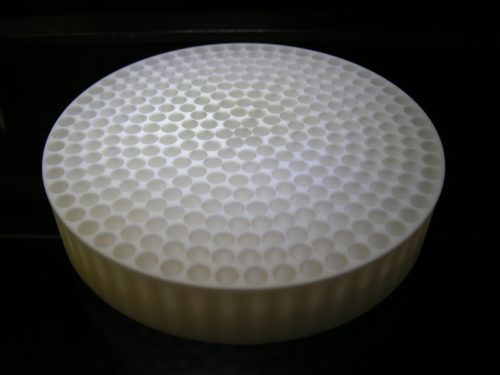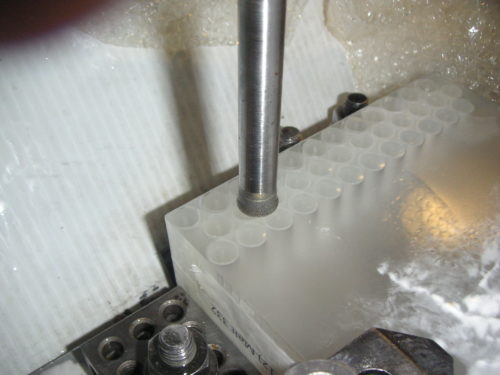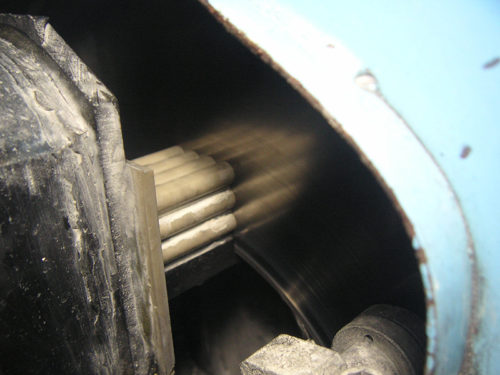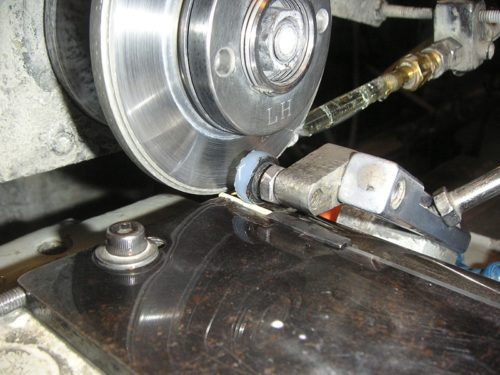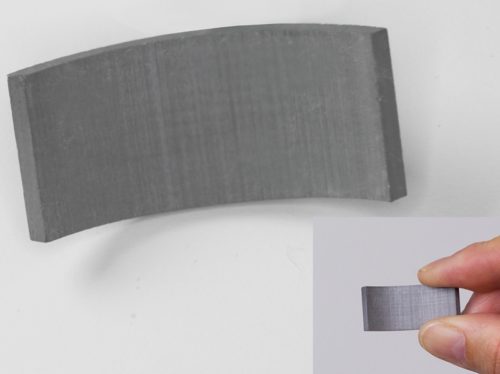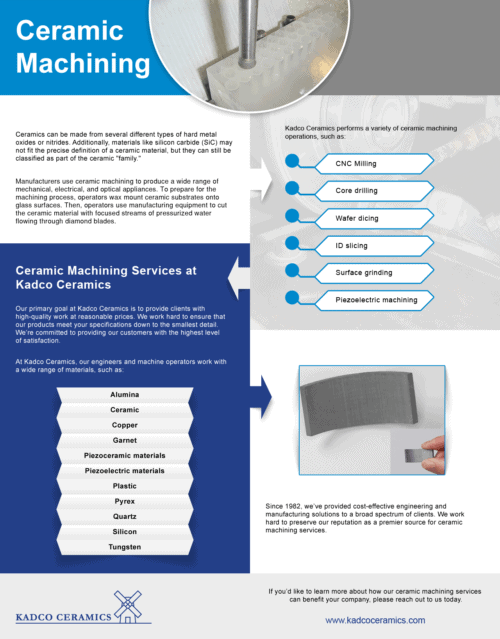Ceramics can be made from several different types of hard metal oxides or nitrides. Additionally, materials like silicon carbide (SiC) may not fit the precise definition of a ceramic material, but they can still be classified as part of the ceramic “family.”
Manufacturers use ceramic machining to produce a wide range of mechanical, electrical, and optical appliances. To prepare for the machining process, operators wax mount ceramic substrates onto glass surfaces. Then, operators use manufacturing equipment to cut the ceramic material with focused streams of pressurized water flowing through diamond blades.
Kadco Ceramics performs a variety of ceramic machining operations, such as:
- CNC Milling
- Core drilling
- Wafer dicing
- ID slicing
- Surface grinding
- Piezoelectric machining
Our experienced machinists ensure that Kadco delivers high-quality work that meets or exceeds client specifications.
CNC Milling and Core Drilling
Two common machining services that Kadco offers are CNC milling and core drilling.
CNC Milling
CNC milling stands for computer numerical control milling. Milling is very similar to drilling and cutting, and CNC milling machines perform both of these operations at a variety of angles.
CNC milling is a highly customizable automated machining process. Equipment used for this technique rely on computerized controls and specialized cutting tools to create the desired product by progressively removing material from the workpiece.
How does a CNC milling machine work? The milling process moves through the same four production stages as other machining models. These stages are:
- The design of a CAD (computer-aided design) model for the product
- The CAD model’s conversion into a CNC program
- Setup of the CNC milling machine for operation
- Execution of the milling operation
CNC milling machines may be either horizontally or vertically oriented depending on the nature of the cutting operations as well as the properties of the target material. The milling machine’s rotating multipoint (or “multi-tooth”) cutting tools perform the desired milling operations according to the instructions from the CNC program.
Milling operations in which the machine feeds the target material along with the rotation of the cutting tool are known as climb milling processes. In contrast, milling operations that feed the moveable workpiece against the tool’s rotation are referred to as conventional milling processes.
Upon completion of the milling operations, the product passes over to finishing and post-processing operations.
Core Drilling
Core drilling removes a cylindrical core from the drill hole. A core drill comprises three main parts:
- motor
- handle
- drill bit or bits
The drill bit(s) are typically coated with either diamond or carbide. Core drills used for concrete generally have diamond-coated drill bits, whereas masonry core drills use carbide-coated bits.
Many types of core drills are in use today. These range from small core drills used by homeowners for DIY projects to huge core drills that cut concrete on big construction projects.
Core drilling allows for the clean removal and analysis of a core of the material. In other applications, where the desired outcome is simply the formation of a hole, the core is discarded.
Wafer Dicing
Wafer dicing is a machining process that separates dice from a wafer of semiconducting material. This separation is accomplished through scribing and breaking, mechanical sawing, or laser-cutting operations. Upon completion of the dicing process, leftover individual silicon chips are encapsulated in chip carriers and are subsequently used in a variety of electronic applications.
Wafers can generally be tape mounted on a film frame for ease of handling. Alternatively, the wafers can be wax mounted on the glass to increase cutting precision. Kadco Ceramics performs several types of wafer dicing operations, including:
- Bevel cutting: This cutting process creates a V-shaped groove or chamfer in the target substrate.
- Burr control: Combinations of machining tools and speeds can mitigate the burr formed on the target material’s cut edge.
- Chip control: Kadco operators carefully monitor factors such as feed, speed, and coolant flow to ensure that edge chipping levels remain well within specifications.
- Scribing: Scribing, or marking the wafer, can assist in subsequent breaking operations.
- Wraparound metallization: Wraparound metallization provides good grounding properties in microwave circuits.
- Cleaning and packaging: Upon completion of dicing operations, thorough die cleaning ensures that the finalized product is in pristine condition and ready for packaging. In some processes, the target substrate can be coated with a protective layer before dicing begins.
ID Slicing
Inner or internal diameter (ID) slicing operations are an extremely effective way to create repeated cuts on hard, brittle materials. ID slicing saws provide enhanced accuracy.
The ID slicing saw blade is composed of an annular (ring-shaped) apparatus with a diamond-plated internal diameter. This configuration allows for the machine to perform highly precise cutting operations with minimal kerf loss. ID slicing operations are effective for materials as diverse as:
- Silicon
- Piezoceramics
- Ferrites
- Quartz
ID slicing operations typically do not require extensive setup procedures, and they’re usually easy to program. This ease of use often makes ID slicing more cost effective than other methods such as outer diameter slicing or wire sawing.
Surface Grinding
Surface grinding is a common refining and smoothing process. In this process, a grinding wheel or disc removes the roughness from the target material’s surface, and then it refines the workpiece’s surface and edges too tight tolerances.
There are three basic types of surface grinders:
- Grinders with horizontal spindles: In these grinding operations, the flat edge of the grinding wheel contacts the workpiece, leading to high-precision results.
- Grinders with vertical spindles: In contrast with horizontal spindle grinders, vertical spindle or wheel-face grinders remove large amounts of material at a time. The face of the grinding wheel, instead of its edge, comes into contact with the targeted surface.
- Single- or double-disc grinders: Disc grinders can be horizontally or vertically aligned, and they often can grind two sides of the workpiece at the same time.
Piezoelectric Machining
Piezoelectric materials can generate electrical charges when placed under mechanical tension or pressure. Examples of piezoelectric materials include:
- Quartz
- Berlinite
- Topaz
- Tourmaline
- Cane sugar
- Rochelle salt
A number of ceramic types can also be classified as piezoelectric, such as:
- Barium titanate
- Lead titanate
- PZT
- Lithium niobate
- Lithium tantalite
- Potassium niobate
- Sodium tungstate
Piezoelectric machining helps produce a wide range of applications. For example, soft piezoelectric ceramics build ultrasonic transmitters and receivers, microphones, sound transducers, and other electronic products.
Ceramic Machining Services at Kadco Ceramics
Our primary goal at Kadco Ceramics is to provide clients with high-quality work at reasonable prices. We work hard to ensure that our products meet your specifications down to the smallest detail. We’re committed to providing our customers with the highest level of satisfaction.
At Kadco Ceramics, our engineers and machine operators work with a wide range of materials, such as:
- Alumina
- Ceramic
- Copper
- Garnet
- Piezoceramic materials
- Piezoelectric materials
- Plastic
- Pyrex
- Quartz
- Silicon
- Tungsten
Since 1982, we’ve provided cost-effective engineering and manufacturing solutions to a broad spectrum of clients. We work hard to preserve our reputation as a premier source for ceramic machining services.
If you’d like to learn more about how our ceramic machining services can benefit your company, please reach out to us today.

 Thomas Registered Supplier
Thomas Registered Supplier
